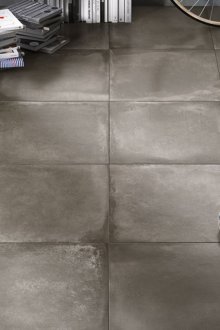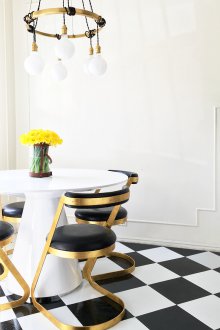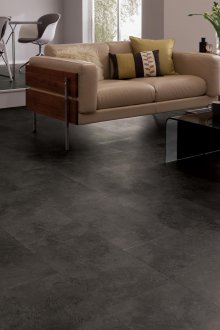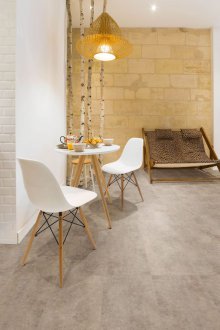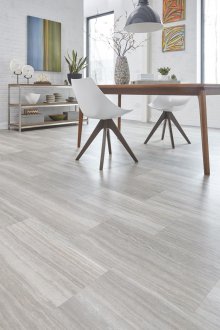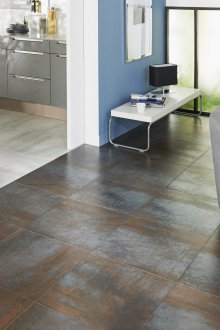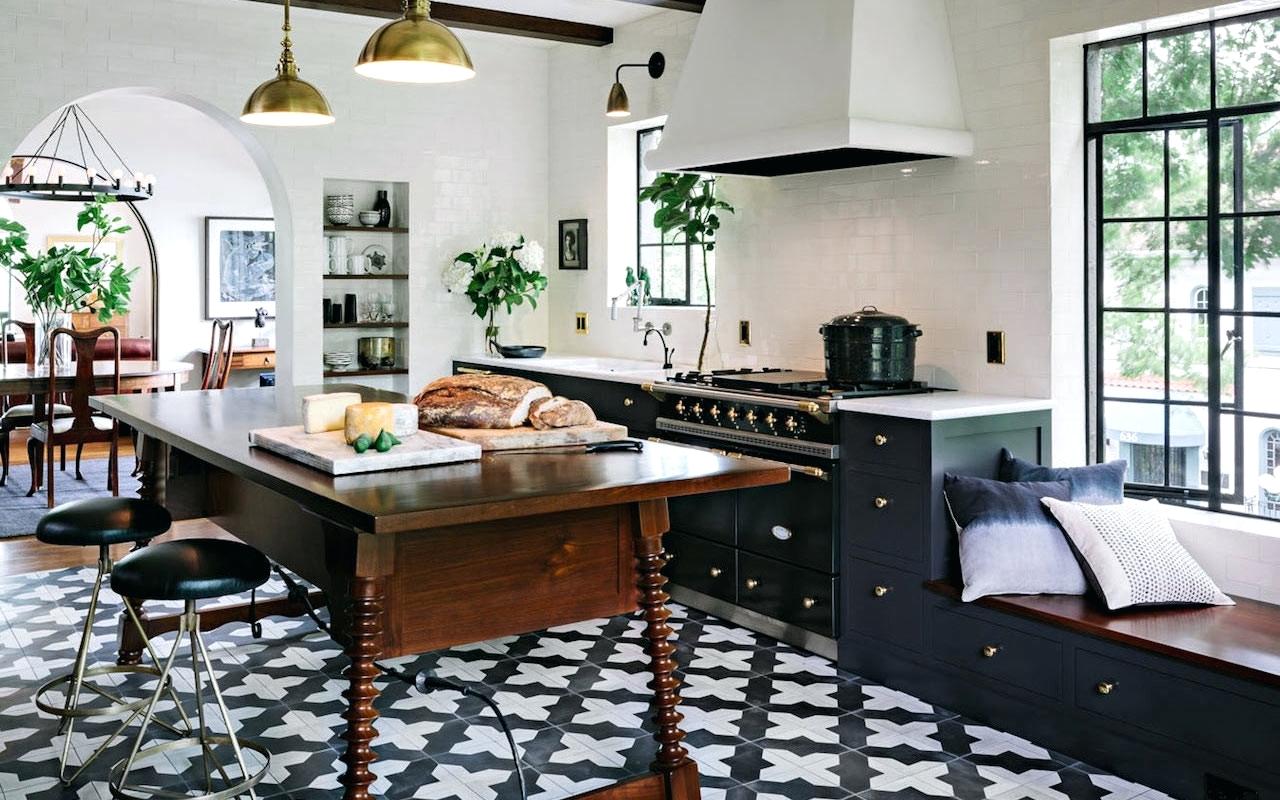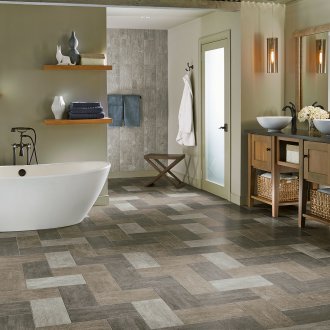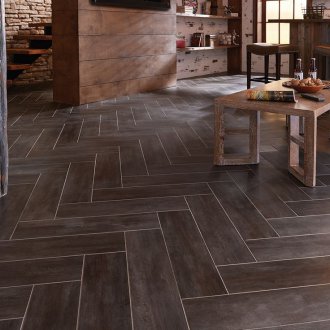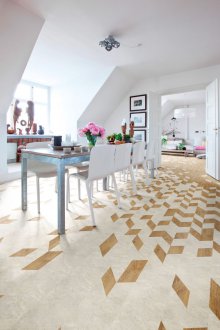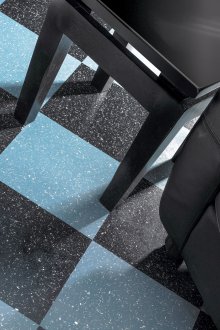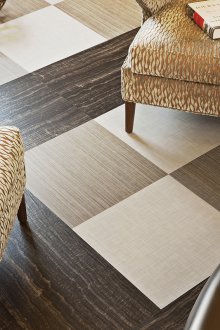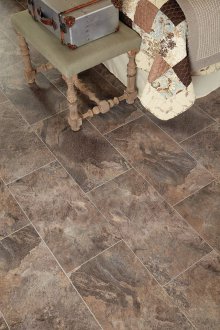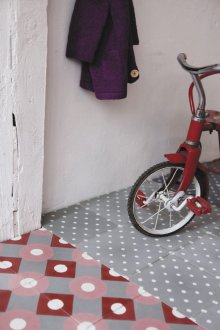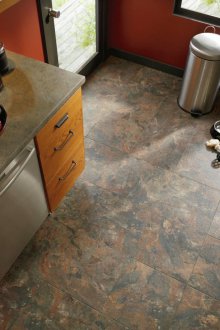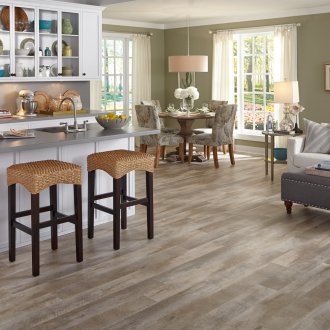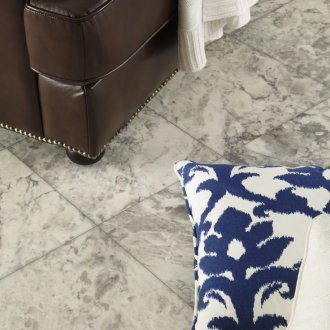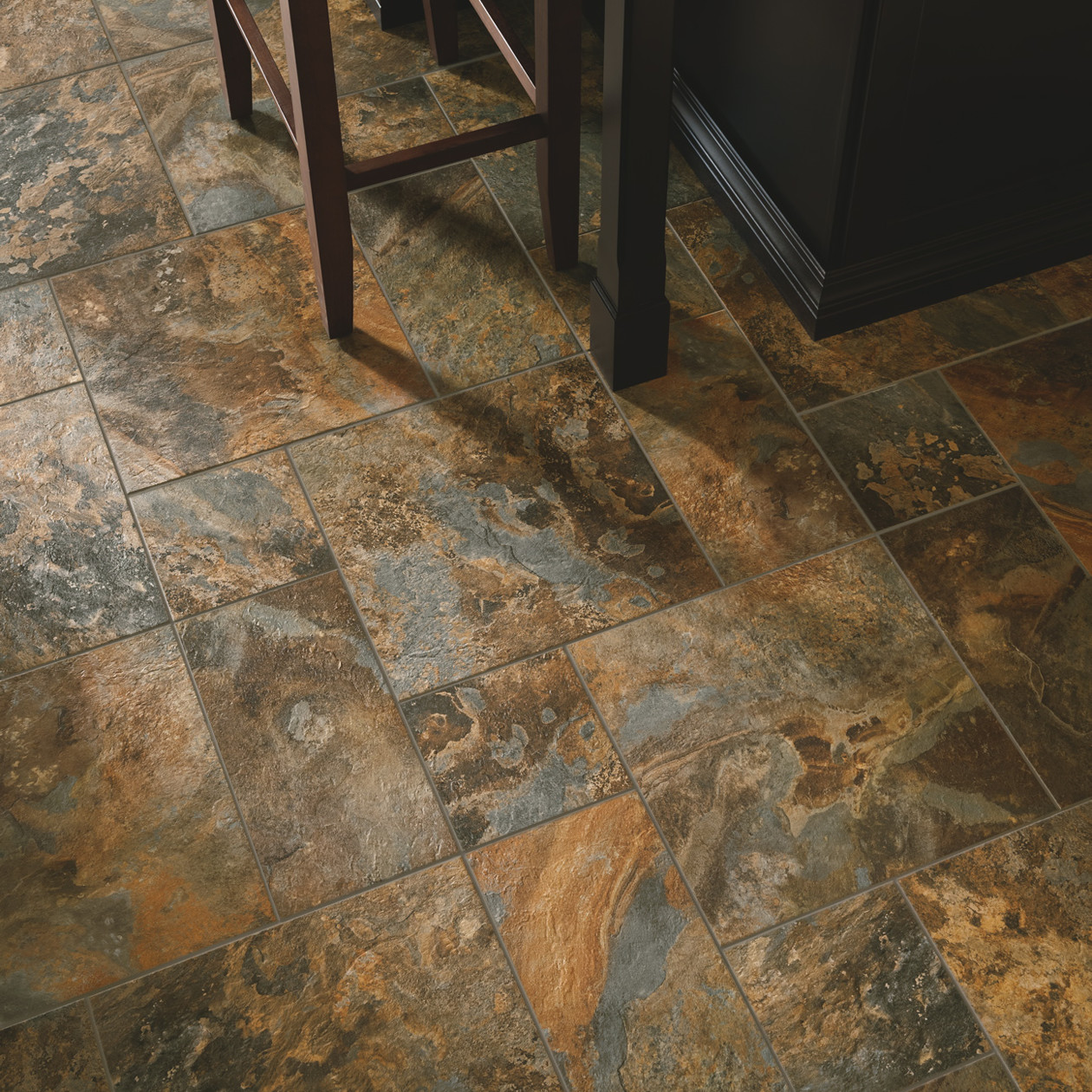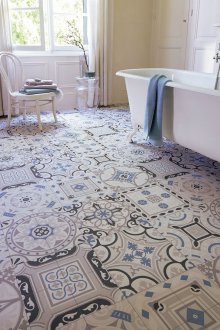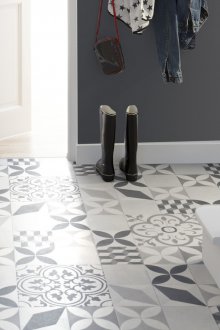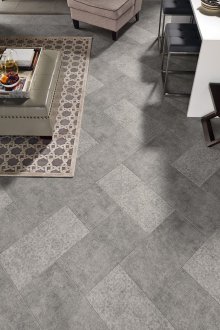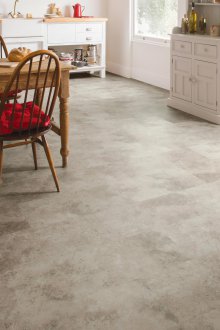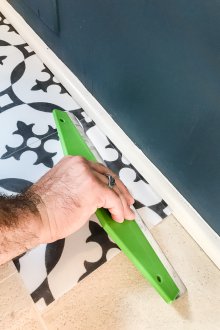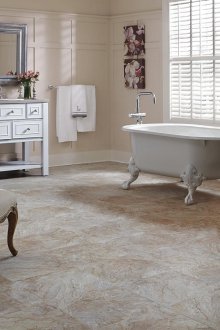Vinyl tile: advantages, disadvantages, varieties, care and scope (24 photos)
Vinyl floor tiles were invented in the thirties of the last century, but became widespread only after the war, standing in line with materials such as linoleum, laminate, natural stone coating. There are many varieties of it, all kinds of colors and sizes, but any tile - from the one that was produced almost a hundred years ago to the modern one - consists of three main layers:
- The main layer. It is the foundation on which the main layers are held. It can consist of polyvinyl chloride, vinyl, quartz, mixed in different proportions and supplemented with useful impurities. It bends easily, but is strong enough so that the tile does not break.
- Decorative layer. It is a field in which the most bizarre design decisions can be deployed. The combination of dyes allows you to give the coating any color, additional impurities can provide texture. It is this layer that allows the tiles laid on the floor to turn it into the sea, into sand, into grass or into abstract fantasy.
- Protective layer. It is a shield that separates the decorative layer from the aggressive external environment. It includes plastic compounds that make the coating insensitive to mechanical stress, moisture, and abrasion.
If we are talking about self-adhesive tiles, then another adhesive layer is added to the rest, which is located below the main layer. It is necessary so that the tile can be easily laid on the floor without worrying about mixing special glue and all the problems that may arise with it.
Vinyl floor tiles are all made according to this, one and the same principle of combining layers. The pros and cons of all species are also the same.
Benefits
Vinyl floor tiles have a number of advantages that distinguish it from the list of other coatings - it is laid easier than laminate, costs less than natural stone, has a longer service life than linoleum. When it comes to vinyl floor tiles, it is customary to highlight the following advantages:
- Long service life. Like any artificial material, pvc floor tiles can serve for many years - different manufacturers give a guarantee for a different period, but rarely it is less than ten years.
- Ecological cleanliness. Vinyl tile is absolutely safe for human and animal health. It does not emit harmful compounds, is not poisonous and cannot cause allergies. Due to this, the whole abundance of its varieties can be stacked even in a nursery.
- Resistance to temperature changes. For self-adhesive tiles, the permissible temperature range is very wide - from minus forty to plus eighty. Even in the hottest parts of the country, the tile will not melt, in the coldest it will not freeze. Moreover, the coating can be used in conjunction with a warm floor.
- Abrasion resistance. Any coating that is walked on is gradually worn away, loses its color and crumbles. PVC vinyl tile is not an exception, but, due to the presence of quartz sand or crushed minerals, the process is slow. Significantly slower than using laminate or linoleum.
- Resistance to mechanical influences. Vinyl tiles for the kitchen, where things often fall, a real salvation.It is resistant not only to abrasion, but also to shock.
- Moisture resistant. Vinyl tiles for the bathroom - the perfect solution, because even the highest concentration of water in the air is not able to damage the coating.
- UV resistant. Almost all coatings fade over time - and laminate, and linoleum, and even wood, but vinyl tiles do not change, even if you place it under the bright sun.
- Roughness. Compared to tile, vinyl floor tiles are a much more suitable option. It cannot be slipped with such ease.
- Ease of care. Vinyl tile is easy to clean - no less than any modern coating.
- Ease of repair. Laminate needs to be removed completely, linoleum too, or re-glued with ugly pieces. There is no such problem with tiles - just remove the damaged element and replace it with a new one.
- The lightness of the tile itself. Transporting the material does not require much effort - and the weight that ultimately rests on the plate is negligible.
- Variety of design. Tiles can be of any color, bears patterns and drawings, imitates the sea, grass, sky. Moreover, you can always order an individual design, which in the interior will look the most advantageous and, having laid that, it will be possible to pass for the original and a person with good taste.
- Easy styling. The tile is made so that it can be laid by any person - even someone who has never been involved in construction. As a base, any coating is suitable, the thickness of the tile is so small that the height of the ceiling ceases to play a role. If necessary, the elements can be cut with a simple knife, so laying vinyl tiles is possible even in the most inaccessible places.
Flexible vinyl tile allows you to design any room - suitable vinyl tile for the walls of the bathroom, for kitchens and partitions between rooms. There are only a small number of disadvantages to consider.
disadvantages
The disadvantages of the tile are not as numerous as the advantages, but in certain circumstances they can outweigh. Among them are usually called:
- Price. Cheap varieties do not serve well, require special care in styling and can swell at the seams. Expensive species fit easier, but not every owner can afford them.
- The need for accuracy at certain stages of work. Crooked tile and will look crooked; insufficiently ironed tiles can swell and form bumps. Beauty and relevance in the interior of a tile coating is achieved only if the vinyl tile was laid in accordance with all the rules.
The rest of the tiles lacks flaws. The noble shimmer of wood is not inherent in it, it is not as reliable as stone, but in its niche, correctly laid and in harmony with the interior, it can become a real decoration of the house.
Varieties
There are many options for tiles - self-adhesive vinyl tiles, household, pressed. Each of them has its pros and cons.
According to the characteristics in operation, it stands out:
- Household tiles. It is suitable for living quarters with low traffic - that is, those where people do not walk constantly for several people. Such tiles can be put in the kitchen, in the bedroom, in the nursery - in fact, any living room in the apartment is characterized as a room with a small cross.
- Commercial tile. It makes sense to engage in the installation of this variety only if people constantly pass through the floor from it. This tile is laid in offices, in shopping centers, in large stores - in rooms that are large in size and which constantly pass through the crowds.
- Tile for special purposes. It is used exclusively in rooms of large sizes, in which conditions imply constant intensive use.Gyms, dance halls, production halls - such tiles can serve for decades in a residential building, but this makes little sense. The loads are too low, and the price is too high.
By the method of laying stands out:
- Tile with lock. The tile with a locking connection is equipped with a special mechanism - on some tiles there are “spikes”, on the other “grooves” in which the “spikes” are fixed. Putting such a tile is very easy, even in a short time, but it can not be used as flexibly as self-adhesive. Cut one tile, give it the desired shape will not work - a device with an adhesive lock will not allow.
- Self-adhesive tile. Self-adhesive tiles have a special layer that allows them to be glued to any non-rough coating by simply removing the protective film. Such tiles can be cut - an advantage that any ceramic tile lacks - can be laid by bending. The main thing is to ensure a sufficient fit, otherwise the coating may come off.
- Glue tile. This option is used when the builder has experience and time. It has all the advantages of the other varieties, but it fits on a special glue that needs to be prepared in advance. It requires accuracy, accuracy and calculation, but in the end it always looks good.
Depending on how experienced the one who puts the tiles, and how free he is in money, the appropriate option is chosen. However, it should be remembered that it is not enough to choose the ideal coating - you also need to know how to position it.
Scope of a tile and care of it
It’s not enough to figure out how to lay the tiles - you also need to know where to lay. Most often it is used:
- In the bathrooms. The tile is not sensitive to moisture, does not deteriorate from temperature changes. If it is laid correctly and there are almost no joints between it, you can not even use the rug, getting out of the bathroom - you still can’t slip due to the roughness of the material.
- In the kitchens. Something constantly falls on the kitchen floor, sweet or easily soiled liquids are spilled, flour is scattered. It’s very simple to remove all this from vinyl tiles - and nothing will harm her, will not change her appearance.
- In the nurseries. Young children often scatter something, drop it, the most unpleasant surprises happen around them. None of this can damage the vinyl tile floor - and the child will not be able to slip and fall, which is also important.
- In the hallways and corridors. In a place where all the guests enter and where they constantly need to be washed, vinyl tile is more appropriate than ever. The main thing is that it should not be white, otherwise you will have to spend all the time cleaning.
In addition to accommodation, proper care is also important. The tile is undemanding, but it can remain truly bright, attractive and aesthetic only if it is properly looked after.
It is necessary:
- Wash. A usual wet rag, without damaging the tile in any way, will remove all dirt and debris from it. You can also use a vacuum cleaner or a broom. It is important to clean the tiles with a dry cloth after wet cleaning.
- Apply specialized tools. There are vinyl cleaning fluids that will make the tiles as clean as possible. They should be used, and not aggressive agents and bleaches (their use will not benefit, even if the tile itself is white).
Vinyl tile is an excellent material that is suitable for almost all rooms where reliability, durability and attractive appearance are needed. The main thing is to choose the right variety and avoid mistakes when laying.
